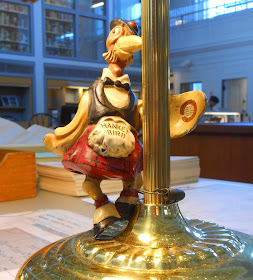 During the 1950s, Salvador Dalí began working on a series of watercolor illustrations to accompany Dante's Divine Comedy. These illustrations, which follow the trajectory of Dante's journey through hell, purgatory and heaven, were commissioned by the Italian government to mark the 700th anniversary of Dante's birth in 1965. But when word got out that a Spaniard instead of an Italian had been recruited to create the artistic tribute to one of Italy's greatest literary legacies, a general public outcry broke out, pressuring the government to revoke the commission. Undeterred, Dalí pushed forward on his own to complete the series, and found enthusiastic support from the French publisher Joseph Forét. The project was eventually taken up and completed by the French publishing firm Les Heures Claires, which released Dalí’s work in 1965 as a suite of limited edition prints to accompany an exquisitely letter-pressed, six-volume set of Dante’s Divine Comedy.
During the 1950s, Salvador Dalí began working on a series of watercolor illustrations to accompany Dante's Divine Comedy. These illustrations, which follow the trajectory of Dante's journey through hell, purgatory and heaven, were commissioned by the Italian government to mark the 700th anniversary of Dante's birth in 1965. But when word got out that a Spaniard instead of an Italian had been recruited to create the artistic tribute to one of Italy's greatest literary legacies, a general public outcry broke out, pressuring the government to revoke the commission. Undeterred, Dalí pushed forward on his own to complete the series, and found enthusiastic support from the French publisher Joseph Forét. The project was eventually taken up and completed by the French publishing firm Les Heures Claires, which released Dalí’s work in 1965 as a suite of limited edition prints to accompany an exquisitely letter-pressed, six-volume set of Dante’s Divine Comedy.The prints consist of one hundred color woodcuts, which carefully recreate Dalí’s watercolors, capturing their subtle washes of color and delicate linear drawing. It took the woodcut artists over five years to hand-carve 3,500 wooden blocks. Throughout the printing process, anywhere from twenty to as many as thirty-seven separate blocks were needed to reproduce each individual watercolor.
Dalí’s illustrations of Dante’s Divine Comedy are far from a literal engagement with the medieval Italian text. Implementing a psychoanalytic lens, Dalí extracts the metaphoric potential of Dante’s poetry. Dalí’s aesthetic idiom to represent dreams versus reality derives from explorations of the unconscious and subconscious.
Most of the Inferno and Purgatorio prints contain motifs referencing the elementary nature of human drives. Dali’s surrealist practice translates man's sins and frailties into unconscious drives. Crutches, bones perforating skin, soft or crystallized bodies, scatological and cannibalistic metamorphoses abound in his interpretation of the medieval text. For instance, Dalí’s interpretation of the twenty-eighth canto in Inferno, "The Hypocrites," plays with the crutch motif, with the naked Caiaphas nailed to the ground. In this print, the crutches indicate social weakness, flaccidity and vulnerability, but most importantly, the evil speeches of hypocrisy. One of the deceitful tongues, which a hypocrite is known to have several of, has been overused and hangs limply over a crutch. Caiaphas grasps desperately at another tongue as he simultaneously clutches his innards spilling from his body. The remaining two tongues are nailed to the floor.
Another illustration that draws heavily from psychoanalysis and surrealism is the print accompanying the first canto in Purgatorio. In this print, "The Fallen Angel" examines the drawers of his body. This iconography recalls the famous 1936 Venus de Milo with Drawers. Dalí used this sculpture, as well as the fallen angel illustration, to symbolize the ways in which Freud's analytical tools could be used to scrutinize the human soul.
To take a look at Dalí's surrealist illustrations of Dante's Divine Comedy, come to Rauner and ask for Presses S153dadi.



